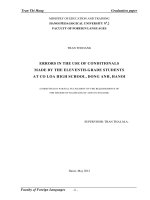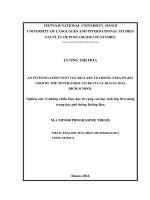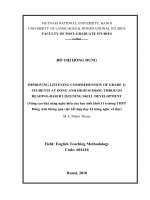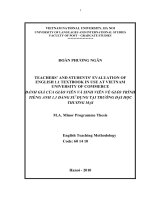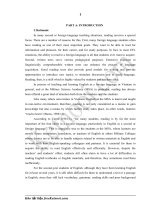A study on the effectiveness of using debate technique to improve speaking skills of the tenth - grade students at Dong Anh high school
Bạn đang xem bản rút gọn của tài liệu. Xem và tải ngay bản đầy đủ của tài liệu tại đây (611.71 KB, 59 trang )
HA NOI PEDAGOGICAL UNIVERSITY 2
FOREIGN LANGUAGES FACULTY
LE THI DIEU
A STUDY ON THE EFFECTIVENESS OF USING DEBATE TECHNIQUE
TO IMPROVE SPEAKING SKILLS OF THE TENTH-GRADE
STUDENTS AT DONG ANH HIGH SCHOOL
SUBMITTED IN PARTIAL FULFILLMENT OF THE REQUIREMENTS OF
THE DEGREE OF BACHELOR OF ART IN ENGLISH
HÀ NỘI, 2017
HA NOI PEDAGOGICAL UNIVERSITY 2
FOREIGN LANGUAGE FACULTY
LE THI DIEU
A STUDY ON THE EFFECTIVENESS OF USING DEBATE TECHNIQUE
TO IMPROVE SPEAKING SKILLS OF THE TENTH-GRADE
STUDENTS AT DONG ANH HIGH SCHOOL
SUBMITTED IN PARTIAL FULFILLMENT OF THE REQUIREMENTS OF
THE DEGREE OF BACHELOR OF ART IN ENGLISH
SUPERVISOR:
MRS. NGUYEN THI LE NGUYEN, MA.
HÀ NỘI, 2017
ACKNOWLEDGEMENTS
I would never have been able to finish my research without the guidance of my
supervisor, the help from friends, and the support from my family.
Foremost, I would like to express my sincere gratitude to my supervisor M.A.
Nguyễn Thị Lê Nguyên for her patience, encouragement, enthusiasm and continuous
support on my study. Her guidance helped me in all my time of writing the research. I
could not have imagined having a better supervisor and mentor.
My sincere thanks go to all of my fellows for their willingness to help me at any
time when I was lost or in trouble.
Last but not least, I take this opportunity to express my deepest thanks to my
family for their giant support, encouragement and love.
i
ABSTRACT
This study is based on the importance of speaking skill. Speaking is important
to be learnt because it is the way to communicate with other people in order to deliver
opinions and express ideas, but in fact, the students’ ability of speaking English is low.
This research was aimed to see the effectiveness of debate technique in teaching
English speaking. The sample was thirty six tenth grade students at Dong Anh High
school. Eighteen students of 10A3 class were treated as the experimental group and
eighteen students coming from 10A2 class were as the control group.
The writer employed experimental design and used both quantitative and
qualitative methods with convenience sampling. The research instrument were oral
speaking tests( pre-test and post-test),a questionnaire and video-based observation.
Based on the data collected from test scores the researcher found out there was a
significant difference in the main gains between the students’ speaking scores taught
by classroom debate and students taught without it. The implementation of classroom
debate increased the students’ speaking scores. In addition, the other purpose of this
study was to make an inquiry about students’ perceptions on employing classroom
debate to improve speaking skills. All students from 10A3 class at Dong Anh High
school were assigned to take part in speaking classes in which used debate technique
in seven weeks. Based on the data collected from survey questionnaire, the researcher
found out that the students believed that debates made their speaking class more
interesting and effective. Moreover, learning speaking through debate boosted their
confidence, and helped them overcome the stage of fright to talk more. Last but not
least, the findings from video recordings indicated that during the speaking lessons
applying debate students’ teamwork skill was developed. They were more active in the
class and showed their enthusiasm and interest to share their own opinions.
ii
STATEMENT OF AUTHORSHIP
Title:
A STUDY ON THE EFFECTIVENESS OF USING DEBATE TECHNIQUE TO
IMPROVE SPEAKING SKILLS OF TENTH-GRADE STUDENTS AT DONG
ANH HIGH SCHOOL.
I hereby certificate that the work submitted in my research is entirely of my
own hand, or, where copied from any other person’s work has been acknowledged in
reference and that the report is originally written by me under instructions of my
supervisor.
Date submitted: 24thApril, 2017
Student
Supervisor
Lê Thị Diệu
Mrs. Nguyễn Thị Lê Nguyên, M.A.
iii
LIST OF ABBREVIATION
HPU2
: Hanoi Pedagogical University 2
EG
: Experimental Group
CG
: Control group
i
LIST OF TABLES AND GRAPH
Tables
Table 1. Population ...................................................................................................22
Table 2. Sample .........................................................................................................23
Table 3: Students’ opinions on using debate in teaching speaking after seven
speaking lessons ........................................................................................................32
Graphs
Graph 1: Speaking scores of the control group before and after being taught by
traditional way ..........................................................................................................30
Graph 2: Speaking scores of the experimental group before and after applying
debate ........................................................................................................................ 31
Graph 3: Percentage of “Yes” and “No” answers in 7 lessons ............................... 34
ii
TABLE OF CONTENT
ACKNOWLEDGEMENTS ...........................................................................................i
ABSTRACT .................................................................................................................. ii
STATEMENT OF AUTHORSHIP............................................................................ iii
LIST OF ABBREVIATION ..........................................................................................i
TABLE OF CONTENT .............................................................................................. iii
PART I: INTRODUCTION
I. Rationale of the study ................................................................................................ 1
II. Aims of study ............................................................................................................2
III. Research questions ..................................................................................................3
IV. Significance of the Study ........................................................................................3
V. The scope of study .....................................................................................................4
VI. Methods of the study ............................................................................................... 4
VII. Population and sample .......................................................................................... 4
VIII. Design of research work ......................................................................................4
PART II: DEVELOPMENT
CHAPTER ONE: LITERATURE REVIEW
I.2. Speaking English .....................................................................................................8
I.2.1. Origin of speaking English ..................................................................................8
I.2.2. Teaching speaking English ..................................................................................9
I.3. Debate .....................................................................................................................13
I.3.1. Understanding debate ........................................................................................ 13
I.3.2. The benefits of debate ........................................................................................ 14
I.3.2. The disadvantages of debate .............................................................................15
I.3.3. Debate to improve speaking skill ......................................................................16
iii
I.3.4. Components and formats of a debate in speaking classes.............................. 17
CHAPTER TWO
METHODOLOGY
II.1. Research design ...................................................................................................20
II.2. Research context ..................................................................................................22
II.2.1. Population and Sample ....................................................................................22
II.2.1.1. Population ......................................................................................................22
II.2.2.2. Sample ............................................................................................................22
II.2.2. Research instruments .......................................................................................23
II.2.3. Planning .............................................................................................................26
II.2.4. Data collection procedure ................................................................................28
II.2.5 Data analysis procedure ....................................................................................29
PART III: DISCUSSIONS AND FINDINGS
III.1. Finding of pre-test and post-test .......................................................................30
III.2. Finding of the questionnaire .............................................................................32
III.3. Finding of video-based observation .................................................................33
III.4. Discussions. .........................................................................................................35
PART IV: CONCLUSION
IV.1. Summary of the study ........................................................................................ 39
IV.2. Limitations ..........................................................................................................40
IV.3. Suggestions for further study ............................................................................40
REFERENCES ............................................................................................................42
APPENDIX A
APPENDIX B
iv
APPENDIX C
v
PART I
INTRODUCTION
This part discusses the rationale of the study, the aims, the research questions, the
significances and the scope of the study. The methods and the design of the research
are also presented in this part.
I. Rationale of the study
While there are hundreds of different types of languages spoken in hundreds
of countries resulting in the language barriers, English serves as a bridge to connect
people all over the world. English is certainly the most common international
language in the globe due to the fact that English is used in many sectors including
Economy, Policy, Diplomacy, Tourism, Medicine, Science and Technology, etc.
Therefore, learning English as a second language or foreign language are very
fundamental especially for Vietnamese students at universities, for the ability to
speak English is one of the principle requirements of employees and stakeholders
alike to meet the demands of the global economy. Additionally, in accordance with
the National Ministry of Education in Kepmendiknas No. 22/2006 who states that
English is a tool for communicating both in written and oral, we may conclude the
main goal of study English in school is as a preparation of communicating with
other people, in any context, when English is required. Of four main skills named
speaking, writing, reading and listening, Bailey (1993) says that speaking is the
center skill and the most demanding. As a result, although a good performance in
English requires students to be competently in all aspects: reading, writing,
speaking and listening, English teachers are expected to focus on guiding their
learners to master speaking ability fluently and correctly.
Nowadays, more and more people desire to become skilled at English
speaking. However, at many high schools and universities in Vietnam in general
and Dong Anh High school in particular, speaking English is not a favorite skill. In
fact, last year when being as a trainee teacher in this high school, the researcher
1
discovered that many students were quite passive in speaking classes and seemed to
be shy to share ideas with other students or the teacher. Furthermore, they seem to
not be interested in speaking lessons. Hence, to speak English precisely and fluently
turns out to be a big challenge indeed. This finding was supported by ideas from the
students and some other teachers who teach English in Dong Anh High school that
speaking classes were often ineffective because students rarely interact in English.
Among some activities enriching students’ ability to speak English like:
game and role-play in CLT (Communicative Language Teaching) accordance to
Littlewood (2008) or in order to raise the students’ voice in the speaking classes,
various activities have been suggested for English speaking class such as group
work, discussion, pair-work, simulation and games (Kayi, 2006; Nunan, 2003;
Burns, Anne and Joyce, 1997). Debate is one of these techniques and is not the new
one but it helps to develop strong listening skills, self-confident (Bradley, 1959).
Maryadi (2008) states that debate can motivate students thinking, moreover if they
must defend their stand or opinion which is in contradiction with conviction of
them. This strategy can involve all students to be active, not only debate performer.
One study reveals that debate tends to encourage students to use their linguistic
knowledge in real communication context and situation, especially in oral
communication; it increases their ability and capability in speaking English
(Mabrur, 2002). But, debate technique hasn’t been used widely and frequently for
teaching speaking at Dong Anh High school.
All reasons mentioned above have inspired the researcher to carry out the
study titled “A study on the effectiveness of using debate technique to improve
speaking skills of tenth grade students at Dong Anh High school”.
II. Aims of study
The main aims of the study are:
To investigate the effectiveness of using the debate technique in
developing students’ speaking ability in speaking classes.
2
To the students’ perception toward the speaking classes in which teacher
use debate as a teaching technique.
III. Research questions
In order to achieve the aims mentioned above, some questions are formulated
as follow:
1)
Whether or not using debate technique in teaching speaking can
improve speaking skills of tenth grade students at Dong Anh High school?
2)
What are the students’ perceptions toward debate in speaking lessons?
IV. Significance of the Study
The present research is believed to have several significances for theoretical,
practical, and professional benefits.
Theoretical benefit
The research findings can be used as the contribution toward the
research about using debate technique to teach English speaking.
Practical benefit
The research findings will be useful to teachers, students and also the
readers who are interested in teaching English especially for those in
Dong Anh High School environment. It is expected to help teachers to
get alternative ways in their teaching process, especially by using
debate.
Professional benefit
The research problem can help teachers to improve the quality of
teaching, students’ relationship, and to create an interesting study
environment in English speaking classroom.
This thesis helps the writer to develop her knowledge and experience
in composing academic writing.
3
V. The scope of study
Due to the limitation of time and the researcher’s knowledge, the object
of this study is focused on teaching speaking using debate method in a few
speaking classes of tenth grade students at Dong Anh High school (class 10A3
and 10A2).
VI. Methods of the study
In order to set up a firm theoretical background for the study, relevant
publications are critically reviewed.
Experimental Method was applied to answer the research questions.
To collect the data, the following techniques have been applied: Survey
questionnaire , speaking oral tests( namely pre-test and post-test), video-based
observation.
VII. Population and sample
1. Population
The population of this research was the tenth grade students in two classes
(10A3 &10A2) in Dong Anh High school.
2. Sample
Among two tenth grade classes, eighteen students from each class were
selected to be an experimental group and a control group. In this way, eighteen
students from class 10A3 were in the experimental group and eighteen from class
10A2 were in the control group.
VIII. Design of research work
The research work has four main parts: Introduction, Development,
Discussions and Findings and Conclusion.
Part 1: The “Introduction” consists of the rationale, the objectives, the scope,
the significance, the method and the design of the study.
4
Part 2: The “ Development” consists of two chapters:
Chapter one is entitled “Literature Review”. This chapter reviews the
previous studies, the literature review in brief, the definition of
speaking English, teaching speaking, as well as the definition of debate,
the advantages and disadvantages of using debate in teaching speaking
English.
Chapter two is entitled “Methodology”. It describes the research
method used in this research. It is composed of the description of the
subjects and procedures of making research.
Part 3: The “Discussions and Findings” presents the result of research and
the analysis of the data.
Part 4: In the “Conclusion” the researcher gives a brief summary of the
study and also provide some limitations and suggestions based on the
findings as well.
5
PART II
DEVELOPMENT
CHAPTER ONE
LITERATURE REVIEW
This chapter involves the literature review in brief, some issues related to
speaking English, teaching speaking English and debate.
I.1. Previous researches
Nuraeni (2014) conducted his work name “The Effectiveness of Classroom
Debate to Improve Students’ Speaking Skill”. This study obtained that using
classroom debate was effective technique to improve students’ speaking skill. The
author applied the experimental research design and found out that there was a
significant improvement after they learnt classroom debate. The students’ problem
in comprehension, fluency, vocabulary, pronunciation and grammar were solved
and the speaking scores were significantly improved. Moreover, there was a
positive effect of using classroom debate towards the students’ speaking skill.
Therefore, classroom debate was effective to improve students’ speaking skill. The
researcher also suggested that classroom was a new technique to be used in the class
so teacher should give the students more explanation about how to run themselves
in the debate court to make sure they know what to do.
A study entitled “In-Class Debates: Fertile Ground for Active Learning and
the Cultivation of Critical Thinking and Oral Communication Skills” conducted by
Kennedy (2007) in Bloomsburg University of Pennsylvania. The researcher
concluded that debates went beyond mastery of the content as students also
developed critical thinking skills, such as recognizing inconsistencies and
identifying assumptions. The students could apply these skills in many different
situations. Similarly, debates demanded the development of oral communication
skills, which were vital for success in most careers.
6
Zare and Othman (2015) studied “Students’ Perception toward Using
Classroom Debate to Develop Critical Thinking and Oral Communication Ability”.
The purpose of this study was to make inquiries about students’ perception on
employing classroom debate to improve critical thinking and oral communication
ability. By providing random sixteen students a number of open-ended questions
and conducting semi-structures interviews after they took part in debates for nine
sessions throughout one whole semester, the researcher presented the students
believed that the classroom debate was a constructive learning activity. In addition,
Classroom debate was an active method to teaching and learning which increases
learning in various domains. For instance, it helped learners in mastering the course
content, improving critical thinking, and oral communication skills. Specifically,
debate helped learners to develop critical thinking by looking into arguments,
getting involved in research, collecting information, conducting analysis,
challenging assumptions, evaluating arguments, and illustrating interpersonal skills.
It created an atmosphere in which learners abandon their passive roles and started to
be active participants in the learning process. Learners could use these abilities and
skills in various situations. Likewise, classroom debate helped develop oral
communication abilities, which were essential for accomplishment in nearly all
professions.
Taloko (2013) conducted his work name “Teachers’ & Students’
Perceptions on The Implementation of The English Debate Training in a Vocational
High School in Surabaya” .The purpose of this study was to compile the
perceptions of both English teachers and students of “X” Vocational School via
questionnaires about the implementation of the English debate trainings which had
been done. The result of this study revealed that both the English teachers and the
students believed that debate helped them in improving the students’ English
speaking skills, speaking fluency, and critical thinking. Additionally, debate helped
the students to aware of their society, especially in the terms of the issues happening
in the society and its connection with the social life.
7
Trudeau (2006) worked on “Get Them to Read, Get Them to Talk: Using
Discussion Forums to Enhance Student Learning”. He found out that, joining
discussion forum before class did help students actively engaging in classroomrelated activity outside of the classroom by posting reflections and reading postings
from other students.
The last relevant study selected by the writer was written by Rubiati from
IAIN Waliso Semarang University with the title “Improving Student’s Speaking
Ability through Debate Technique”. The research was aimed to describe the
implementation of debate technique to improve student’s speaking skill and to
identify how much student’s speaking skill improvement after being taught by using
debate technique at the first semester students of English Language Department
Tarbiya Faculty at IAIN Walisongo Semarang in the academic year of 2010/2011.
This research used classroom action research as research methodology. The result
stated that the implementation of debate in teaching speaking was successful
because the students’ mean score was increased and students had a lot of
opportunities to practice speaking in speaking class. The researcher concluded that
debate was an appropriate technique used in teaching speaking.
The researcher has benefited from these studies in choosing sample and
research instruments or designing debate activities. Besides, reviewing them and
has enriched the researcher’s background and extended her scope in this regard,
which considered to be a guidance for research to conduct this study.
I.2. Speaking English
I.2.1. Origin of speaking English
Of all four key language skills, speaking is deemed to be the most important
in learning a second or foreign language. It is explained in various ways by a
number of experts.
According to Brown and Yule (1983), speaking is the skill that the students
will be judged upon most in real-life situations. It is an important part of everyday
8
interaction and most often the first impression of a person based on his/her ability to
speak fluently and comprehensively.
Speaking can be defined as a communicative procedure focusing on meaning
construction that engages in creating, obtaining and processing information (Burns
& Joyce, 1997). Speaking ability though refers to verbal communication ability in a
practical, functional and precise way using the target language. Speaking is an
important skill and the main key to communication for both ESL/EFL learners and
teachers.
Chaney (1998) stated that speaking is the process of building and sharing
meaning through the use of verbal and non-verbal symbols in a variety of contexts.
According to Scoot (2005:79) “Speaking is consider as the productive and
oral skill. Speaking is a cognitive skill, is the idea that knowledge became increase
automatically through successive practice”.
According to Nunan (2003:48) “Speaking is the productive oral skill. It
consists of producing systematic verbal utterance to convey meaning”.
Alternatively, Nunan (1999: 216) indicates that speaking requires learners to
not only know how to produce specific points of language such as grammar,
pronunciation, or vocabulary ("linguistic competence"), but also understand when,
why, and in what ways to produce language ("sociolinguistic competence").
Adopted these previous definitions, the researcher can conclude that
speaking is a process of sharing with others knowledge, interest, attitudes, opinions
or ideas. And speaking skill is the ability to say, to address, to make known, to use
or be able to use a given language in the actual communication.
In the light of these highlighted definitions, the researcher can compose an
operational definition of speaking skill in this study as speaking is the ability to
produce meaningful utterance or discourse orally to address other people and to be
accurate in using grammar and vocabulary.
I.2.2. Teaching speaking English
9
Many teachers agree that students should learn to speak the second language
by interacting with others. So, students should master several speaking components
such as comprehension, pronunciation, grammar, vocabulary, and fluency. In brief,
English teachers should be creative in developing their teaching/ learning process to
create good atmosphere, improve the students' speaking skill, give attention to the
speaking components, and make the English lesson more exiting. For this reason,
the English teacher should apply appropriate methods and techniques of teaching
speaking. The method used by the teacher is communicative approach.
In general, to communicate is to express a certain attitude, and the type of
speech act being performed corresponds to the type of attitude being expressed. For
example, a statement expresses a belief, a request expresses a desire, and an
apology expresses regret. As an act of communication, a speech act succeeds if the
audience identifies, in accordance with the speaker's intention, the attitude being
expressed which is realized in the language. Therefore, some researchers and
experts have tried to assign the notion of teaching speaking like Nunan (2003:48)
who has clarified it as to teach English language learners to:
1. produce the English speech sounds and sound patterns;
2. use words and sentence stress, intonation patterns and the rhythm of the
second language;
3. select appropriate words and sentences according to the proper social
setting situation and subject matter;
4. organize their thoughts in a meaningful and logical sequence;
5. use language as a means of expressing values and judgments, and
6. use language quickly and confidently.
Nunan (2003: 55, 56) also proposes five principles for teaching speaking. Below
are the descriptions:
a. Be aware of the differences between foreign language and second language
learning context.
10
Personally, teaching speaking is the way for students to express their
emotions, communicative needs, interact with other people in any situation, and
influence the others. For this reason, in teaching speaking skill it is necessary to
have clear understanding involved in speech.
While foreign language context is one where the target language is not
the language of communication in society, second language is.
b. Give students practice with both fluency and accuracy.
Accuracy is the extent to which students’ speech matches what people
actually say when they use the target language. Fluency is the extent to which
speakers use the language quickly and confidently, with few hesitations or
unnatural pauses, false starts, word searches, etc. Teacher must provide students
with fluency-building practice and realize that making mistakes is a natural part
of learning a new language.
c. Provide opportunities for students to talk by using group work or pair work,
and limit teacher talk.
It is important for us as language teachers to be aware of how much we
are talking in class so we do not take up all the time the students could be
talking. Pair work and group work activities can be used to increase the amount
of time that learners get to speak in the target language during lessons.
d. Plan speaking tasks that involve negotiation for meaning.
Learners make progress by communicating in the target language because
interaction necessarily involves trying to understand and make teacher
understood. This process is called negotiating for meaning. It involves checking
to see if you have understood what someone has said, clarifying your
understanding, and confirming that someone has understood your meaning.
e. Design classroom activities that involve guidance and practice in both
transactional and interactional speaking.
When we talk with someone outside the classroom, we usually do it for
interactional or transactional purposes. Interactional speech is communicating
11
with someone for social purposes. Transactional speech involves communicating
to get something done, including the exchange of goods and/or services.
12
I.3. Debate
I.3.1. Understanding debate
Debate is well enough known as arguing ideas between two opposite sites
demands students to be able to defend their opinions so it requires good ability to
speak English well.
A debate is about the real or simulated issue. The learners’ roles ensure that
they have adequate shared knowledge about the issue and different opinions or
interest to defend. At the end of activity, they may have to reach a concrete decision
or put the issue to a vote (Littlewood, 1981)
As Quinn (2005) said in his book, Debate, “debating give you chance to
meet new people and new ideas. Best of all, you have the opportunity to stand up
and argue with someone in public, in a stimulating and organized dispute about real
issues” (p.1). It means that facilitates student to discuss their ideas and try to
convince people. Debating is an important and interesting way to discuss issues
facing our society. Students have to speak with some evidences and defend their
opinions to win the debate. Debate allows students to know many different people
with different ideas.
Another opinion comes from Mulholland (2002) that in a formal debate, a
strong developed personal need and strong social preference are presented for
manageable agreement and disagreement. The two intertwined and affect the
formulation of a very high proportion of speech behaviors produces in interaction. It
means that debate has a huge amount of interaction role among people because
people want a confession of ideas about disagreement. In presenting the confession,
the debate will strongly show their characteristic of speech behaviors during
interaction.
Based on opinions above the researcher can assume that debate is a more
communicative interaction that involves opposite point of views and builds critical
and strong characteristics. In form of classroom debate, it presents opportunities for
students to engage and use extended chuck of language for a purpose to
13
convincingly defend one side of an issue. Debates are most appropriate for
intermediate and advanced learners who have been guided in how to prepare for
them. Debate is an activity in which students take up positions on issue and defend
their position; therefore to prepare students for debate, teachers have to make sure
that students have been given all the necessary information in order to research and
present their side of the issue.
I.3.2. The benefits of debate
Some people believe in debate as training for law or politics. Actually for the
vast majority of debaters, participating in debate is about training for everyday life.
Debating can be the ultimate multi-task school activity since it involves research,
writing, speaking, listening and teamwork. Adapted from a journal by Kennedy,
debate as an active instructional strategy is aimed to enhance learning particularly in
the areas of mastering the content and active engagement, developing critical
thinking skill, oral communication skills and empathy.
a. Mastering the content and active engagement. Students learn more affectively
by actively analyzing, discussing and applying content in meaningful ways rather
than by passively absorbing information. Students learn best when applying what
they are learning. In the class, debate cultivates active engagement of students and
placing the responsibility of comprehension for individual and teamwork. Debate
encourages students to re-read and re-think both their own and the opposing
position more intensely than is necessary to repeat lecture material. The students’
approach dramatically changes from a passive approach to an active one. Through
debate, students can improve their comprehension toward the issues.
b. Developing critical thinking skills. Because debate requires listeners and
participants to evaluate ideas, it develops higher-order psychological functions as
well as critical thinking skills. The lower order thinking skills of knowledge,
comprehensions and application focus on rote learning or what students should
14
think, whereas the higher order thinking skills of analysis, synthesis and evaluate
focus on how to think.
c. Oral communication skills. Students with debate experience are significantly
better at employing the three communication skills: analysis, delivery and
organization. The students receive extensive criticism and feedback and measure
against established educational standards so they have to show fluent explanation,
exact pronunciation and use correct grammar. Implementing debate in speaking
class can help students to achieve over standards.
d. Developing empathy. When students debate they listen to both sides of the
argument. They do see both sides, rather than just seeing it from one point of view.
Debate is one way to minimize instructor bias. By learning both side of a
controversial topic, student are more open-minded and better able to see another
person’s view debate also provides opportunities to developing empathy as students
give consideration to various viewpoints.
I.3.2. The disadvantages of debate
In the learning process, debate has limitations too. According to Malley and
Pierce (as cited in Rubiati, 2010), there are many disadvantages of debate while
using it in the classroom. Firstly, debate technique only can be used for specific
subjects, such as subjects that are concerned with agreeing and disagreeing and
giving argument. Secondly, debate needs a long times for preparation. Much
preparation is needed in debating in order to make sure that the debate runs well.
Students should prepare their arguments before the debate to make it easier for them
to attack the opponent’s opinion. Finally, it requires the students to be controlled in
defending their argument. Many students can’t control their emotion when they
defend their opinions. Although it has these disadvantages, it seems that the benefits
do outweigh the disadvantages in the development of English speaking. Moreover,
its disadvantages can be minimized by the teachers.
15
